PRODUCT MANAGEMENT
Digital Menu System Implementation for Restaurants
Led the deployment of a tablet-based digital menu system by managing stakeholders, aligning scope with business goals, and driving continuous improvement through progress tracking and feedback.


Strategy | Agile | Data-Driven Insights
PROBLEM STATEMENT
How can I enhance operational efficiency and customer satisfaction in a growing restaurant by implementing a digital menu and POS system to reduce errors, speed up service, and improve profitability?
EXECUTIVE SUMMARY
About This Project:
Despite strong sales growth, the restaurant chain faces challenges such as staff burnout, delayed service, and flat profit margins. Operational inefficiencies and long wait times are impacting customer satisfaction.
Opportunity:
The solution is to implement a tablet-based digital menu and POS system to streamline ordering, reduce errors and accelerate service.
My Role:
As Product Manager, I identified key challenges, and developed a solution to optimize operations and improve the customer experience. I also created the project charter, project plan, evaluation report for stakeholders, closeout report, and impact report.
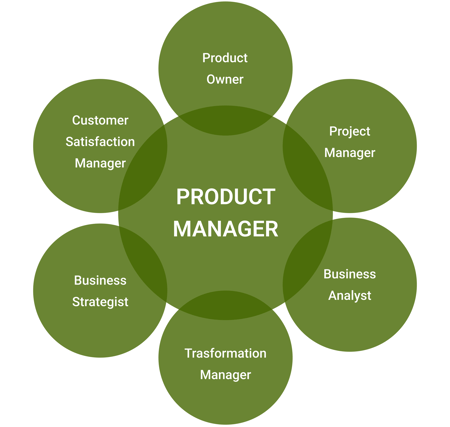

Laying the Foundation
The journey began with a Project Proposal, outlining the business case for tablet-based menu ordering. Recognizing the industry’s shift towards digital transformation, I presented a compelling argument for how this technology could increase table turnover rates, reduce order errors, and improve guest experience while supporting staff efficiency.
PROJECT TITLE
Tabletop Menu Tablets Rollout
PROJECT MANAGER
Peta (First in-house Project Manager)
OVERVIEW
Sauce & Spoon, a growing restaurant chain, is launching a pilot rollout of digital menu tablets in the bar area at two locations: Sauce & Spoon North and Sauce & Spoon Downtown. The goal is to streamline the ordering process, improve efficiency, reduce wait times, and enhance the customer experience. The tablets will also provide valuable data for tracking key metrics.
SCOPE
The project will involve rolling out tablet systems at the bar section in each of the selected restaurants. The pilot phase will allow for testing tablet features like menu item add-ons and upselling options, as well as integrations with existing POS and host systems.
TIMELINE
The pilot rollout is set to start at the beginning of Quarter 2, with preparation taking place during the previous quarter. If possible, an earlier launch will be considered due to seasonal lulls in traffic.
PROJECT PROPOSAL
PROJECT SUMMARY
PROJECT DELIVERABLES
Increase Product Mix: Upsell specific items such as appetizers or featured entrees using tablet features that suggest add-ons or display coupons.
Reduce Table Turn Time: Aim to decrease average table turn time by 30 minutes, improving guest turnover and reducing wait times, especially in the bar area.
Improve Customer Experience: Streamline ordering and payment to reduce delays, leading to higher customer satisfaction and increased guest counts (+10%).
Reduce Food Waste: Minimize food waste caused by incorrect orders and comped meals. This can be achieved by ensuring clearer communication of guest orders through the tablet system.
Integrate with Existing Systems: Ensure the tablet system is compatible with current POS and host systems for smooth operation and minimal disruption.
PROJECT GOALS
Pilot Rollout Plan: A detailed strategy for implementing the tablet system in the bar areas of Sauce & Spoon North and Downtown, including configuration, installation, and testing.
Tablet Features: Review and select a tablet package that includes menu item promotions, coupons, and integrates well with current restaurant systems (POS and host software).
Staff Training Plan: A program to onboard and train staff on using the new system, ensuring smooth adoption and addressing potential resistance to change.
Metrics for Success: Define key performance indicators (KPIs) such as table turn time, customer satisfaction, guest counts, and food waste reduction to measure the effectiveness of the tablets.
Once approved, the Project Charter formalized our objectives, scope, timeline, and key stakeholders. With a six-month timeline (March–September 2025), I led the planning phase, ensuring every milestone aligned with business goals and operational constraints.
PROJECT CHARTER
PROJECT SUMMARY:
The Sauce & Spoon Tablet Rollout Project aims to introduce an integrated tablet system across multiple Sauce & Spoon restaurant locations to enhance operational efficiency, improve customer service, and streamline the restaurant’s ordering process. By implementing a tablet-based solution, Sauce & Spoon seeks to optimize staff workflows, increase customer satisfaction, and ultimately improve profitability.
This project aligns with Sauce & Spoon’s ongoing efforts to innovate and scale its operations, ensuring the sustainability and growth of the restaurant group.
PROJECT TITLE
Tablet Rollout for Order Accuracy and Operational Efficiency
START DATE: March 2025
END DATE: September 2025 (Estimated)
STAKEHOLDERS:
Omar Mubarak – Owner & CEO (High Power, Low Interest)
Deanna Coleman – Director of Operations (High Power, High Interest)
Carter Ward – Executive Chef (High Power, Medium Interest)
Gilly Tyson – General Manager (North) (Medium Power, High Interest)
Alex Schmidt – General Manager (Downtown) (Medium Power, High Interest)
Nia Williams – General Manager (Waterfront) (Medium Power, High Interest)
Zane Dutchman – Kitchen Manager (North) (Medium Power, Medium Interest)
Larissa Stein – Kitchen Manager (Downtown) (Medium Power, Medium Interest)
Seydou Diallo – Restaurant Technology Consultant (Medium Power, High Interest)
PROJECT GOALS:
Improve order accuracy and speed by introducing tablet-based ordering.
Enhance kitchen efficiency through digital integration and reduced manual errors.
Provide a seamless guest experience with an intuitive and user-friendly ordering interface.
Establish a scalable technology solution for potential future expansion across all locations.
Minimize disruption to existing operations by implementing a structured rollout and staff training plan
DELIVERABLES:
Fully functional tablet ordering system implemented at pilot locations.
Staff training sessions and documentation.
Kitchen workflow adaptation to integrate with the new system.
User feedback collection and analysis.
Performance metrics report to assess system effectiveness and guide future scalability.
SCOPE AND EXCLUSIONS:
In-Scope:
Research, selection, and implementation of tablet technology tailored to restaurant operations.
Deployment of tablets at three pilot locations: North, Downtown, and Waterfront.
Integration with existing Point-of-Sale (POS) and kitchen operations.
Ongoing monitoring and performance analysis of the pilot phase.
Collaboration with the technology consultant for seamless system implementation.
Training and onboarding of restaurant staff (front-of-house and kitchen staff).
Ongoing support and troubleshooting during the rollout phase.
Out-of-scope:
Immediate rollout to all Sauce & Spoon locations beyond the pilot phase.
Development of new proprietary software (existing third-party solutions will be used).
Major renovations or structural changes to accommodate tablet use.
Overhaul or redesign of existing restaurant facilities.
PROJECT MILESTONES:
Project Kickoff:
March 2025 – Official start of the project with stakeholder meetings and initial planning.Tablet System Selection and Customization:
April 2025 – Evaluate and select tablet system, with customization based on the restaurant's specific needs.Pilot Launch at North Location:
June 2025 – Launch pilot system at the North location, including staff training and technical support.Pilot Expansion to Downtown and Waterfront Locations:
July 2025 – Expand the rollout to include Downtown and Waterfront locations based on pilot feedback.Full Implementation and Staff Training Completion:
August 2025 – Full deployment across all three locations with final staff training and troubleshooting.Project Evaluation and Closeout:
September 2025 – Review project outcomes, gather feedback, and close out the project.
APPENDIX:
Stakeholder Analysis, Power-Interest Grid
Stakeholder management strategy - Regular status updates to stakeholders, feedback collection from pilot locations
Risk analysis and mitigation strategies for resistance from staff, technical issues and customer feedback
SMART Goals
PROJECT MANAGER: Peta M
END DATE: Deanna (Director of Operations)
OBJECTIVES:
Deploy Tablet System Across 3 Locations:
The tablet system will be rolled out across the North, Downtown, and Waterfront locations to improve the ordering and kitchen management process.Improve Operational Efficiency:
Reduce wait times, improve order accuracy, and streamline staff workflows with real-time communication between the kitchen and the front of house.Enhance Customer Experience:
Enable faster order-taking, upselling, and accurate billing for customers, resulting in improved customer satisfaction and repeat business.Train Staff and Build Capacity:
Provide training and technical support for restaurant staff, including front-of-house and kitchen teams, ensuring smooth adoption of the new system.
PROJECT BENEFITS AND COSTS
Benefits:
Increased operational efficiency by reducing manual order-taking errors.
Faster service and improved guest satisfaction.
Better communication between front-of-house and kitchen staff.
Potential long-term cost savings through reduced labor inefficiencies.
Data-driven insights to optimize restaurant operations and menu decisions.
BUDGET AND RESOURCES:
Estimated Budget: $250,000
Tablet hardware and software: $150,000
Staff training and onboarding: $30,000
Consultant fees: $20,000
Contingency and miscellaneous: $50,000
Resources Needed:
Technology Team: For hardware installation and software integration
Restaurant Staff: Front-of-house and kitchen staff for training and system use
Consultants: For technical support and system customization
APPROVAL AND SIGN-OFF:
Project Manager:
Peta M
(Signature)
Date: ___________________
Project Sponsor:
Deanna Coleman, Director of Operations
(Signature)
Date: ___________________
Executive Sponsor:
Omar Mubarak, Owner & CEO
(Signature)
Date: ___________________
High
Influence
Low
High
Interest
Low
Meet their needs
Monitor
Show consideration
Manage closely
Deanna (Director of Operations)
Carter (Executive Chef)
Zane Dutchman (Kitchen Manager North)
Larissa Stein (Kitchen Manager Downtown)
Gilly Tyson (General Manager North)
Alex Schmidt (General Manager Downtown)
Nia Williams (General Manager Waterfront)
Seydou Diallo (Restaurant Technology Consultant)
Omar Mubarak (Owner)
Power-Interest Grid
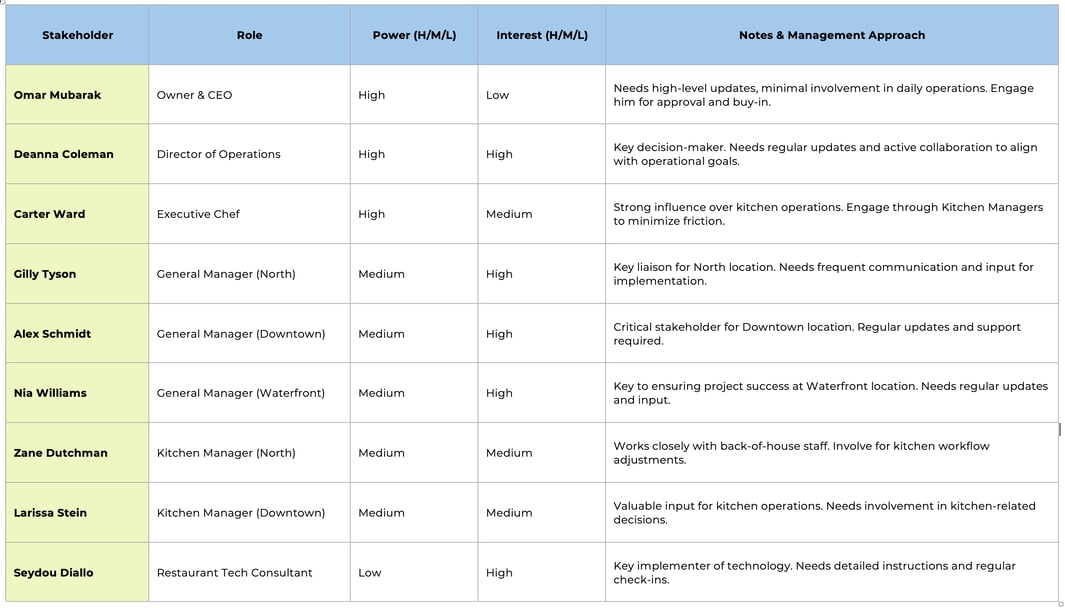

Stakeholder Analysis
Risk Analysis and Mitigation Strategies
Employees may resist adopting the new tablet system
Mitigation: Provide comprehensive training and hands-on support during rollout. Involve key stakeholders early on to ensure buy-in.
Technical Issues with System Integration:
Mitigation: Work closely with the technology team to test and debug the system before full implementation. Ensure Seydou Diallo is actively involved in troubleshooting.
Operational Disruptions During Rollout:
Mitigation: Implement the system in phases and monitor performance closely at each site. Have backup plans for critical systems.
Customer Experience Concerns: Users may encounter issues during their interactions with the tablet, affecting customer satisfaction.
Mitigation: Conduct pilot testing with feedback loops, allowing customers to voice their concerns. This helps in refining the tablet experience based on real-world usage before full-scale deployment.
Project Goals (SMART):
Increase Order Accuracy:
Improve order accuracy by 20% within the first three months of tablet implementation by enabling tablet-based order taking, reducing human error and manual input.Reduce Food Waste:
Decrease food waste by 15% within the first six months post-implementation by using the tablet system to track orders more efficiently, thus reducing unnecessary food preparation due to incorrect orders.Enhance Operational Efficiency:
Reduce service time per order by 10% within four months by streamlining communication between the kitchen and service staff using the tablets.Achieve Staff Training Completion:
Ensure 100% of staff are trained on the new tablet system within the first two months of the project, measured by successful completion of training programs.Maintain System Maintenance:
Ensure the tablet system's operational continuity by budgeting $5,000 annually for maintenance, ensuring that the system remains updated and functional post-rollout.
Stakeholder Management Strategy:
High Power, High Interest (Deanna, Carter):
Engage regularly through one-on-one meetings and direct updates. Include them in key decision-making processes and ensure their concerns and feedback are addressed promptly.
High Power, Low Interest (Omar):
Provide periodic, high-level updates focused on the project’s alignment with strategic goals. Engage him when necessary to ensure continued executive support.
Medium Power, High Interest (Gilly, Alex, Nia):
Involve in discussions and decisions specific to their location’s rollout, providing regular updates on project progress and encouraging their input on any potential issues.
Medium Power, Medium Interest (Zane, Larissa, Seydou):
Keep informed about project developments that directly impact their roles, addressing any operational or technical concerns. Encourage their feedback to improve the system’s effectiveness at the pilot locations.
From Planning to Execution
The Project Plan served as the blueprint for execution, detailing resource allocation, task dependencies, and risk management strategies. I collaborated closely with cross-functional teams—including IT, restaurant management, and frontline staff—to define requirements, conduct vendor evaluations, and set up a phased implementation approach.
However, technology adoption in a high-paced restaurant environment presented unique challenges. To mitigate resistance, I prioritized early stakeholder buy-in, conducting regular training sessions and feedback loops with servers and managers. This proactive engagement reduced pushback and ensured smoother adoption.
PROJECT PLAN
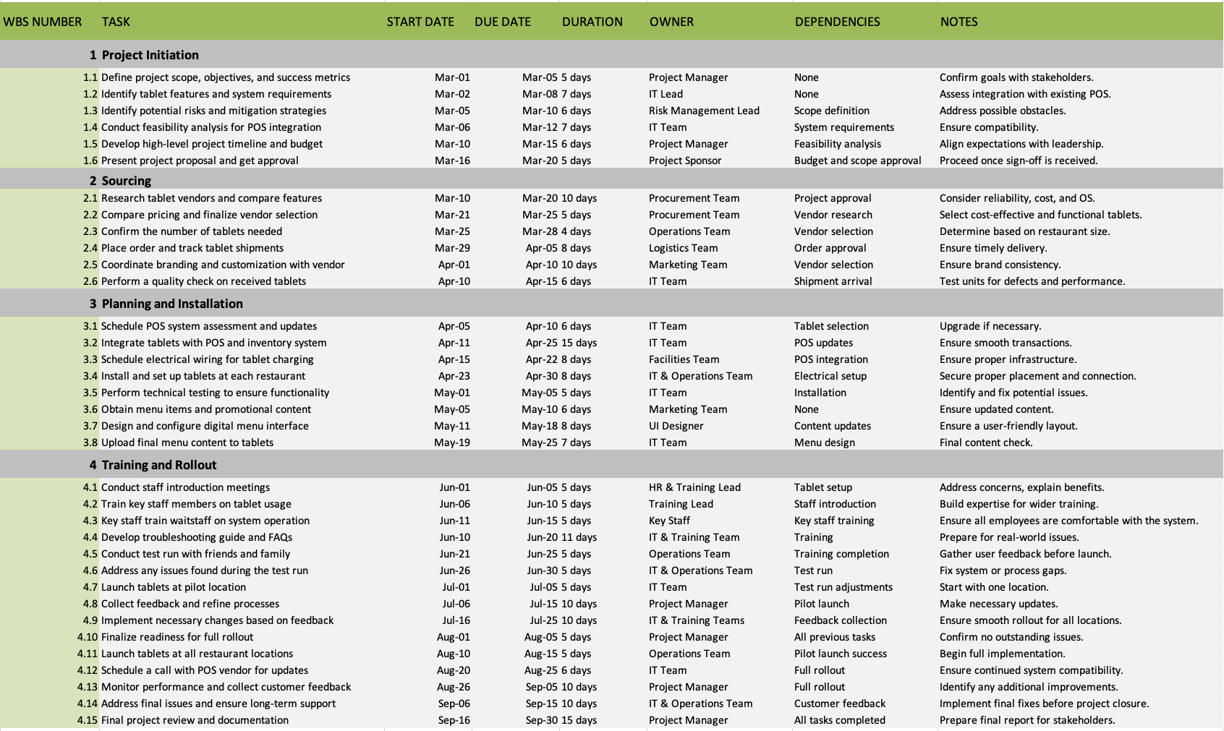

Key Risks & Mitigation Strategies
POS System Compatibility
Risk: Potential integration issues with the existing POS system, especially if updates are required.
Mitigation: Conduct an early assessment of the current POS system to identify any necessary updates. This will prevent last-minute integration issues and ensure smooth functionality.
Technical Failures
Risk: Tablets or software may experience technical issues post-launch.
Mitigation: Develop a troubleshooting guide and ensure vendor support is readily available. Perform rigorous pre-launch testing to minimize issues. Monitor performance closely during the initial rollout and address problems promptly.
Shipping Delays
Risk: Potential shipping delays due to inventory issues.
Mitigation: Build in a buffer for shipping time (7-10 days) and maintain communication with suppliers to ensure timely deliveries.
POS Software Integration Delays
Risk: The POS system may need upgrades, causing delays in integration.
Mitigation: If updates are required, account for an additional 3-6 days in the schedule. Collaborate closely with the POS vendor to ensure compatibility with the tablet system.
Training Phases
Risk: Incomplete or delayed training can affect staff readiness.
Mitigation: Implement a phased training approach: starting with pre-training, followed by manager training, and finally, staff training. This gradual rollout will ensure readiness at each stage.
Menu Updates Delay
Risk: Delays in receiving updated menu information from Carter may cause a delay in content upload.
Mitigation: Proactively follow up with Carter to ensure timely updates and make contingency plans for menu content if there are delays.
Electrician Scheduling Flexibility
Risk: Tight scheduling for electricians may cause delays in installation.
Mitigation: Allow for scheduling flexibility, planning half-day work slots at each location to accommodate the installation process without causing disruptions.
The Primary Quality Standard - Customer Satisfaction
These quality standards include the following five criteria:
Order Efficiency: The average ticket time should be 8 minutes for appetizers and 12-15 minutes for entrées to increase table turnover and reduce customer wait times.
Checkout Speed: Guests should be able to complete the checkout process in one minute or less using the tablets, ensuring a quick and seamless end to the dining experience.
Technical Reliability: Less than 5% of customers should report technical issues with the tablets each week, ensuring a reliable and frustration-free experience for users.
Order Accuracy: Achieve a 98% order accuracy rate, allowing guests to confirm their orders before sending them to the kitchen, minimizing errors and enhancing the dining experience.
Lobby Wait Time: Reduce the average lobby wait time to 10 minutes or less before seating, addressing past customer concerns about long waiting times.
Evaluation questions and indicators based on the quality standards identified earlier
The evaluation questions focus on key quality standards: efficiency, reliability, accuracy, and customer satisfaction.
Indicators will be measured using order time logs, customer surveys, and issue reports to assess whether the new system is meeting expectations.
Results will guide further refinements before rolling out tablets at all locations.
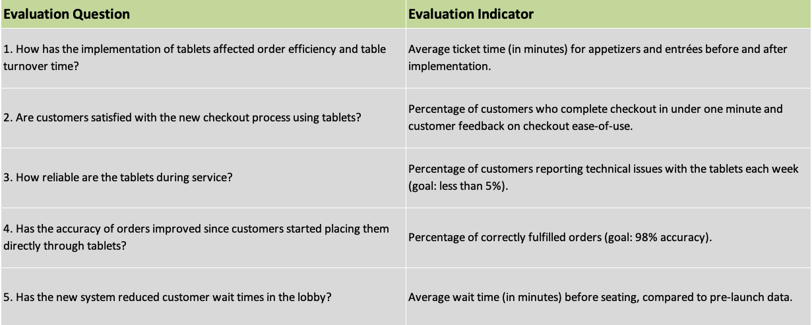

Evaluating Success & Overcoming Challenges
As the pilot phase progressed, Evaluation Findings provided valuable insights into the system’s impact. To communicate these findings effectively, I developed an Evaluation Findings Presentation—a Tablet Test Launch Review & Next Steps, designed specifically for high-level stakeholders and potential investors.
EVALUATION FINDINGS
Sauce & Spoon: Tablet Test Launch Review & Next Steps
SUMMARY OF THE MILESTONE
Successfully conducted a test launch of the new tablet ordering system.
50 customers participated, simulating a full restaurant experience.
Customers provided feedback via a 15-question survey to evaluate the impact
WHAT WE MEASURED
We evaluated key quality standards:
Order efficiency & table turnover – How fast were orders placed and served?
Checkout process – Was it quick and easy?
Tablet reliability – Did customers experience technical issues?
Order accuracy – Did customers receive the correct orders?
Customer satisfaction – Did they enjoy the experience?
KEY DATA POINT - Customer Satisfaction with Checkout Process
Survey Result: 82% of customers agreed that checkout was quick, easy, and secure.
Indicates that the majority of users had a positive checkout experience.
Potential concern: 18% had issues (technical glitches, lack of cash payment option).
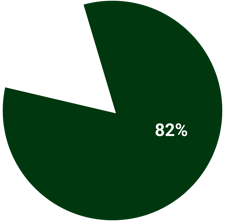

RECOMMENDATIONS
#1 – Improve Order Accuracy


Survey Result: 72% of customers received the correct order, meaning 28% had issues.
Actionable Steps:
✅ Improve the tablet’s order confirmation UI.
✅ Train staff to verify customer orders before sending them to the kitchen.
✅ Implement an easy correction system for mistakes.
#2 – Address Customer Preferences & Technical Issues


88% had no technical issues, but 12% faced glitches (freezing, rebooting).


40% of customers prefer tablet-only ordering, while 30% prefer a mix of tablet and waiter service.
Actionable Steps:
✅ Improve tablet software stability to prevent freezing.
✅ Offer a "Hybrid Service Model" where customers can choose tablet-only or waiter assistance.
✅ Enhance onboarding to ensure customers feel comfortable using tablets.
However, challenges emerged—some customers found the transition impersonal, while technical glitches surfaced during peak hours. Through Retrospective discussions, we gathered valuable insights from both customers and project team members, identifying what worked well and areas that needed improvement.
Through Retrospective Analysis, we distilled critical lessons:
Agile adaptability is key – Iterative user testing should be conducted earlier in the timeline.
Stakeholder involvement drives success – End-users (servers & managers) should participate in initial design phases.
Technical readiness requires proactive planning – Pre-launch stress testing under peak conditions is essential.
Customer experience goes beyond technology – Balancing automation and personal service improves guest satisfaction.
RETROSPECTIVE
lessons learned from customer feedback
lessons learned from project team feedback
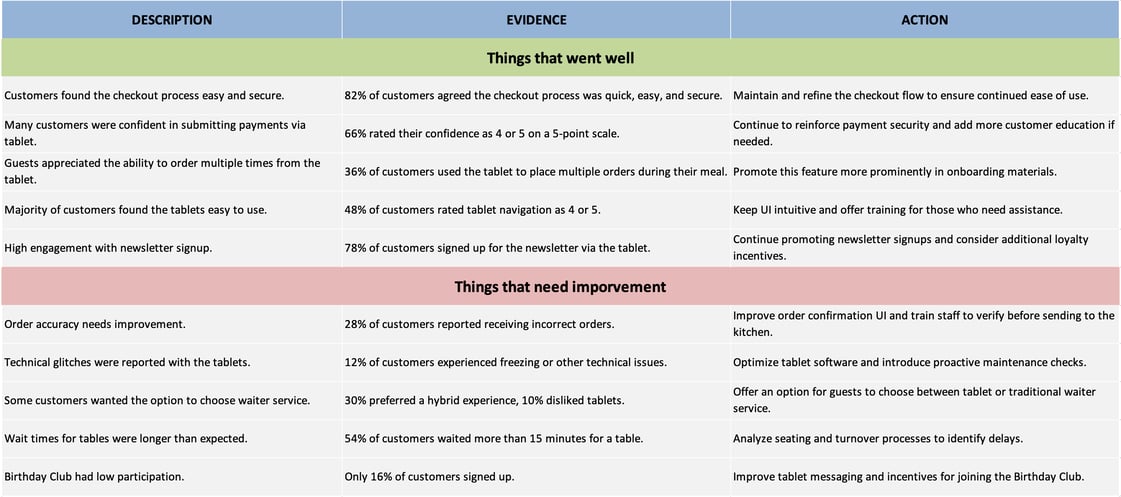

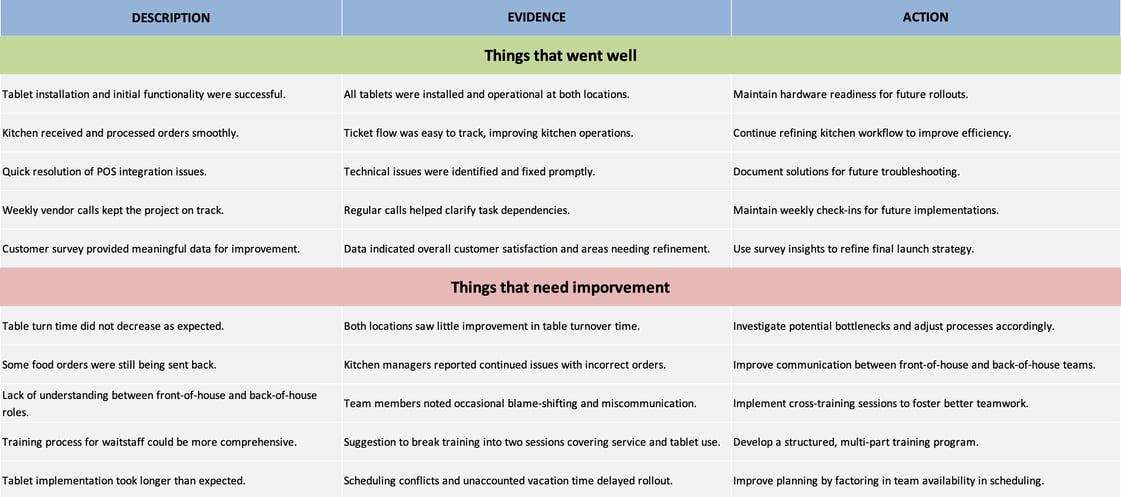

Project Closeout & Impact
By the time of the Closeout Report, the tablet system had been successfully deployed at three locations, leading to noticeable improvements in restaurant efficiency and customer satisfaction.
CLOSEOUT REPORT
PROJECT SUMMARY
The Sauce & Spoon tablet ordering system implementation aimed to streamline the customer dining experience by introducing self-service ordering. The primary objectives were to install tablets at three restaurant locations, reduce table turn times, and improve order accuracy while maintaining high customer satisfaction.
METHODOLOGY
The project followed a combination of traditional and agile project management approaches. A structured plan was used for implementation, with defined milestones for installation, staff training, and system testing. Agile methodologies were applied in refining the system based on customer feedback during the test launch, allowing for iterative improvements to the user interface, payment process, and order management.
RESULTS
Performance Baseline

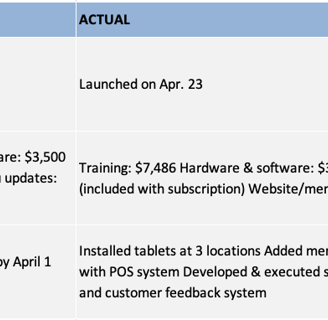
KEY ACCOMPLISHMENTS
Successfully installed and launched tablets at all three locations on schedule.
Reduced table turn time by 30 minutes, improving table availability and guest throughput.
Increased daily guest count by 20% at the Downtown location (goal was 10%).
Reduced food waste by 25%, meeting project targets.
Maintained an average tablet checkout time of one minute or less.
Improved UI navigation based on customer feedback, resulting in higher usability ratings.
Achieved a customer-reported technical issue rate of less than 5% after refining the system.
Enhanced payment messaging to clarify cash vs. card options.
Ensured 76% of customers felt well-instructed on tablet use.
LESSONS LEARNED
Initial navigation issues underscored the importance of user testing before full rollout.
Training and staff engagement were crucial in reducing table turn times.
Kitchen order accuracy remained a challenge, requiring closer coordination with staff.
Some customers still preferred traditional waiter service, suggesting a need for hybrid models.
Pre-service technical testing reduced glitches and improved the guest experience.
NEXT STEPS
Continue monitoring customer feedback for additional usability improvements.
Develop a plan for broader tablet rollout across more locations.
Strengthen kitchen communication protocols to further reduce order errors.
Explore additional customization options for the tablet interface.
Conduct periodic refresher training for staff to optimize system usage.
PROJECT DOCUMENT ARCHIVE
Project Proposal
Project Charter
Project Plan
Evaluation Findings Presentation
The Impact Report highlighted long-term benefits, showcasing operational enhancements and a more streamlined dining experience. More importantly, the project established a scalable framework for future technology integrations across the restaurant chain.
IMPACT REPORT
EXECUTIVE SUMMARY
The Sauce & Spoon tablet ordering project aimed to enhance the dining experience by streamlining order placement, improving table turnover, and reducing wait times. The introduction of tablets provided guests with a faster, more convenient way to browse the menu, place orders, and complete payments.
Two key accomplishments of the project include a 30-minute reduction in table turn time, leading to a 20% increase in daily guest count, and a smoother checkout experience, with over 80% of customers finding it quick and easy. These successes were driven by iterative improvements based on pilot feedback, including UI enhancements and staff training.
Key lessons learned include the need for clearer communication on payment options to accommodate all guests and stronger kitchen coordination to minimize order errors. Addressing these challenges required refining internal processes and reinforcing staff training.
Looking ahead, next steps include continued monitoring of tablet performance and user feedback to ensure sustained success and exploring further integrations, such as mobile checkout, to enhance convenience and adoption rates.
CUSTOMER SATISFACTION: POST PILOT
Q. On a scale of 1-5, please rate your experience with the tablet overall.


This is a chart of Souce & Spoon revenue, showing that after tablet implementation, revenue increased. July revenue was up to 20% over April's monthly revenue.
NEXT STEPS: LOOKING FORWARD
This pie chart illustrates the results from the post-pilot survey. 72% of respondents indicated a customer satisfaction score of 4 or 5.
CUSTOMER SATISFACTION: POST LAUNCH
Q. On a scale of 1-5, please rate your experience with the tablet overall.
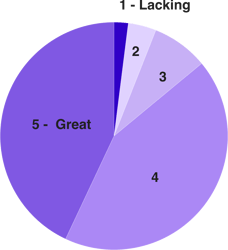

This pie chart illustrates the results from the post-launch survey. 86% of respondents indicated a customer satisfaction score of 4 or 5. This is a 14% increase.
REVENUE
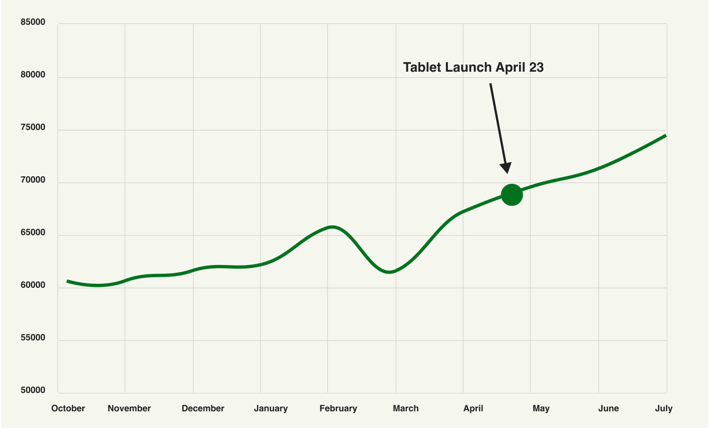

WHAT WORKED: KEY ACCOMPLISHMENTS
Decreased table run time
Implementation of the tablets increased the average daily guest count by 10%
Reduced table turn time by 30 minutes, improving table availability and guest throughput.
Increased customer satisfaction
After the pilot, customer satisfaction was at 72%
Once we implemented improvements based on feedback, customer satisfaction increased to 86%
Decreased food waste
Tablets identified who was receiving an incorrect order.
Kitchen staff has taken the initiative to correct orders and decrease food waste
Increased Sales
Our monthly revenue has increased steadily since the tablet rollout, upwards of 20% since September/ pre-rollout
Tablets also helped boos revenue during the holiday season
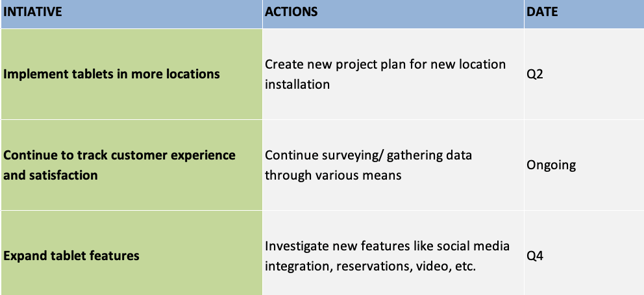

Reflection & Growth
This project refined my expertise in -
Stakeholder engagement
Risk mitigation
Adaptive leadership.
